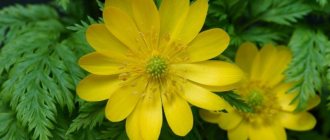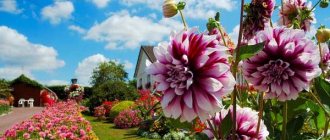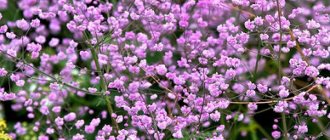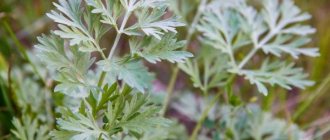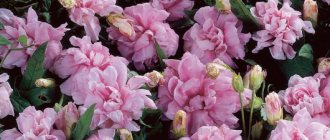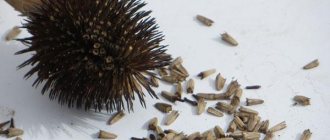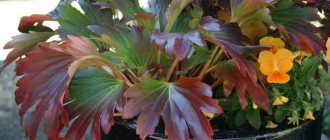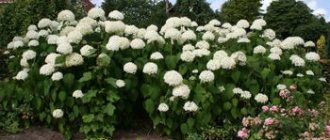Plants » Herbs
0
781
Article rating
Kira Stoletova
Wormwood Schmidt Nana is an ornamental plant. It grows from early spring to late autumn. It is used in landscape design of park areas and urban areas, as well as in private gardening.
Wormwood Schmidt Nana
Characteristic
Artemisia Schmidt is a species of wormwood that comes from the Far Eastern region of Russia and Japan. In garden culture, a variety called Nana, known as Silver mound, is used. This is a small hemispherical semi-shrub with shoots growing in a vertical direction, densely covered with foliage. The leaves of Artemisia Schmidt Nana are thin and narrow silky hairs of a bluish or green color with a silver tint, they are pinnately dissected and densely pubescent.
The advantage of growing Schmidt's wormwood bush in open soil is its rapid growth, which makes it possible to improve the area in a short period of time.
Wormwood shoots form a rounded bush or dense clump growing up to 0.3 m.
The paniculate inflorescences of Schmidt's wormwood grass are located on erect peduncles and are formed by small yellow or light yellow flowers. The flowering period is from August to September.
Types of wormwood
Wormwood can be classified into several types:
- Wormwood. Often, this wild plant is found in fields and along roads. Due to its unusual smell and bitter taste, it began to be used to make alcoholic beverages. In addition, bitter wormwood has medicinal properties that are actively used in folk medicine;
- Tarragon. This herb has found its use in cooking, as a seasoning for meat dishes or pickles;
- The medicinal has a subtle lemon aroma and is known as a natural remedy against moths;
- Ornamental wormwood or another name is garden wormwood. There are low-growing and tall varieties. Flowering wormwood has white or light yellow inflorescences that emit a strong sweetish aroma.
Landing place
Schmidt's wormwood is not demanding on soil quality; it develops fully on poor soils, but with good looseness, and in fertile soils it loses its compactness and grows quickly. Growing in a natural environment in semi-desert and desert, the semi-shrub is a drought-resistant and winter-hardy plant. The selection of soil depends on the type:
- when planting the silver wormwood variety Schmidt, peaty acidic soil is not recommended; it grows well in poor, neutral soil with a well-organized drainage system;
- The green foliage varieties of Artemisia Nana grow in fertile, moist soil.
For planting silver wormwood Nana, the best place is one that is well lit by sunlight; species with green foliage love shade.
Description of wormwood
This plant is very unpretentious; it can grow in almost any conditions.
Wormwood is a shrubby perennial species, reaching from 20 to 150 cm in height, depending on the variety. However, there are annual and biennial plants and herbs, as well as shrubby species.
The stem is straight, the leaves are feather-shaped, on which a whitish coating is observed. Due to this, there is a feeling that the plant glows with silvery colors.
Features of planting and care
Shrub needs pruning
In the process of planting Schmidt's wormwood, river sand is added to the planting hole, which gives the soil the looseness necessary for the subshrub. Additional organic matter provides the plant with better survival.
Watering is carried out rarely, mainly in hot, dry weather.
With increased soil moisture and frequent watering, Schmidt's Silver Mound wormwood acquires a more saturated green hue and at the same time loses its pubescence, losing its decorative appeal.
Wormwood bush grows in open space with great intensity, so in the process of caring for it, it is worth regularly trimming the rhizomes. Pruning allows you to give the shrub the shape of a compact, lush cushion. Limit the growth of the bush in open soil by placing a border around the plant or by growing it in separate pots and containers.
Wormwood shoots are pruned in autumn or spring. When the flower stalks cover the entire plant, the flowers are removed.
Use of garden wormwood
Due to the variety of shades of leaves from bluish-green to bluish-silver, decorative wormwood is actively used for garden decoration. It is also used in decorating border paths or bouquets.
Low-growing varieties are suitable for planting near paths or on alpine hills. To diversify flower beds, tall varieties are used. Sometimes gardeners plant wormwood between currant bushes. This method helps prevent rust from appearing on its leaves.
From spring to late autumn, the shrub retains its bright colors and richness of color, which allows it to be combined with any plants. This is an excellent decoration for a flower bed, which easily tolerates cutting of branches, which allows you to give the plant any shape, depending on the wishes of the designer.
If you dilute wormwood with other aromatic herbs, such as thyme, lavender or sage, you can create a unique fragrant flower garden.
However, do not forget that due to the spread of long roots of decorative wormwood, it is able to move around the garden. Basically, it remains in one place for 2 years, after which it begins to send out small shoots. Therefore, it is best used in compositions that do not have clear boundaries.
Reproduction
Schmidt's wormwood is propagated by seeds, division, root cuttings and cuttings. Reproduction features:
- wormwood seeds are sown in warm greenhouse conditions in April, followed by planting sprouts at a distance of 7-9 cm into potted containers of 1-3 pieces;
- cuttings are carried out from May to July, so that rooting occurs before the onset of the cold season; young and mature shoots 7-10 cm long are taken as cuttings;
- propagation by division is carried out every 2-3 years to rejuvenate the plant, which begins to die off in the central part;
- root cuttings - propagation by dividing the root system of a bush dug out of the ground and planting the divided parts in a new place.
The propagated shoots are temporarily planted on loose sandy soils, followed by planting in a permanent place of growth a year later. During the rooting process, the cuttings are not shaded and watered rarely.
Use in garden decoration
Before you design your garden, you need to know what type of this plant can be grown in a particular area. A plant such as decorative silver wormwood has a strong, literally incomparable smell, as well as an attractive appearance. This culture is used in cooking, cosmetology, medicine, as well as for landscaping gardens and parks. But not all varieties of this crop are decorative, although many of them have visually attractive leaves.
The use of decorative plant varieties in the landscape is very diverse. Silver wormwood is used to create flower arrangements, which, by the way, with their pungent aroma can repel many unwanted insect pests in the garden. With the help of low-growing varieties, alpine slides, borders and rockeries are often decorated. Tall varieties are best suited for decorating a rose garden, flower bed or mixborder.
The juice of the plant is a disinfectant and analgesic. It also helps wounds heal and stops bleeding. An infusion based on Gmelin's wormwood is often used in the treatment of scabies, as a lotion for inflammation of the eyes and periosteum. Wormwood tincture can disinfect the mouth and gums.
This plant was used by our ancestors. On its basis, the most powerful amulets were made, aimed at fighting enemies and troubles, and with the help of various potions, sorcerers caused damage.
Planting Steller's wormwood - step-by-step instructions
Planting wormwood of this variety is quite simple and not tedious, but as a result, the ornamental plant will delight you with a beautiful and impressive appearance and will be an excellent addition to the garden composition. Let's consider a description of the main stages of planting.
Stage 1. Selection and purchase of Steller's wormwood planting material
- First of all, if you want to grow Steller's wormwood on your plot, every gardener needs to think about purchasing planting material.
- You can buy Steller's wormwood at any specialized garden center or nursery that breeds various plants.
- You can purchase crop seeds, as well as grown seedlings and full-fledged seedlings in pots with a closed root system.
- If you have the opportunity to grow plants from seeds, you can purchase this planting material. If you want to get an adult plant in a faster way, it is recommended to buy ready-made seedlings, which go on sale around April or May.
- Before purchasing, be sure to carefully check the planting material. Seedlings and saplings must be without damage, without signs of drying and rotting. When purchasing seedlings in pots, make sure the soil is in excellent condition - there should be no signs of mold.
Stage 2. Choosing a planting site for Steller's wormwood
- At the next stage, it is important to choose a suitable place on the site for planting this crop.
- Steller's wormwood has beautiful silvery foliage, so open sunny places are suitable for it, although seedlings can thrive in light partial shade.
- This plant will grow well in slightly elevated places where there is no stagnation of water, which can have a detrimental effect on the root system of the crop.
- You can choose rocky or sandy terrain, which is also ideal for this type of wormwood.
- When choosing a place for planting, be sure to keep in mind that this is a low-growing plant and is most suitable for planting along borders and garden paths.
Stage 3. Selection and preparation of soil for planting Steller's wormwood
- Light and loose soils are suitable for growing this crop, preferably depleted and without a high content of humus and nutrients.
- In addition, it is important to select areas with neutral soil. When this indicator changes towards acidity, it is necessary to add a little lime to the soil.
- You should not plant Steller's wormwood on clayey and highly moist soils, as this can lead to root rotting.
- Before planting, you need to carefully dig up the area and add a little sand to it for looseness. There is no need to add organic matter or other fertilizers, with the exception of a small amount of humus.
Stage 4. The process of planting Steller's wormwood
- Wormwood seedlings are planted in open ground around the end of April or early May, when the threat of return frosts has passed.
- Before planting, prepare planting holes, the size of which should be slightly larger than the root system of seedlings with a ball of earth. In this case, it is important to leave a distance of 25-30 cm between individual plants. If you plant seedlings in several rows, then you must also leave a space of about 50-60 cm between them.
- At the bottom of the planting holes, you can place a layer of mulch in the form of small stones or gravel to prevent stagnation of water at the roots, which is detrimental to this crop.
- If the seedlings were purchased in pots, then be sure to spill water before planting to make it easier to remove the plant.
- If you do not want the plants to quickly grow in all directions, it is recommended to limit their root system. To do this, when preparing planting holes, you can dig pieces of slate or other limiters around the perimeter. There is another option: plant wormwood in a container and dig it into the ground.
- After planting, be sure to water the plants.



